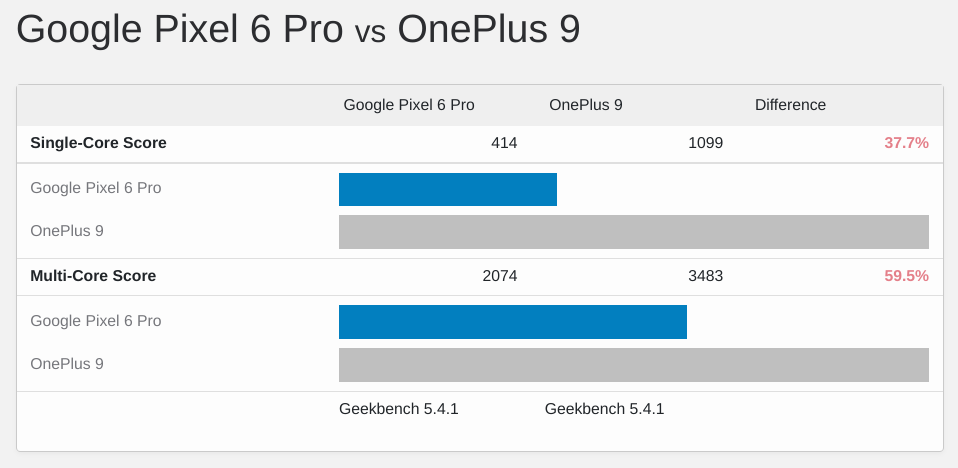Leaked tidbits from a real Pixel 6 Pro unit suggest that the included Google Tensor chip may be one of the fastest chips available for Android phones.
Earlier this year and way ahead of schedule, Google formally introduced the Pixel 6 and Pixel 6 Pro by announcing the Google Tensor chip that will be found within the phones. Where Google has previously enhanced its phones with components like the Neural Core, which processed photos and handled some Google Assistant features, and Titan, its dedicated security hardware, the Tensor chip would integrate those into its own design for efficiency.
While Google being surprisingly open about the Tensor chip and its improvements, the company has left a lot of details unshared. For instance, we don’t know how well the chip will perform against competitors from Qualcomm, Samsung, or even Apple.
Over the weekend, a listing for the “Pixel 6 Pro” appeared on Geekbench, a common tool for benchmarking computers and smartphones that shares many of the specs of that device. While this may seem like a goldmine — and for a time, it was — it didn’t take long for people to begin crafting fake “devices,” uploading the results, and watching as outlets refer to them as “leaks.”
This is even proven out by another Geekbench listing for the “Pixel 6 Pro,” posted the same day, which appears to have a Qualcomm processor, an obvious contradiction and forgery. Because of how easy it can be to fake these listings, each one has to be taken with a grain of salt.
That said, the folks at XDA cite a source with a real Pixel 6 Pro model in hand. This source was reportedly able to corroborate some of the details of the more plausible Geekbench listing — along with many other Pixel 6 tidbits — including a few details about the Google Tensor processor set to debut in the Pixel 6 series. The crucial details about the Google Tensor chip XDA’s source supported are the arrangement of the processor cores as well as their frequencies, which together are enough to puzzle out the full design.
For years, most ARM processors in smartphones conformed to a “big.LITTLE” design that used a cluster of more powerful (or “big”) cores for demanding apps/games while a cluster of power-efficient (or “little”) cores handled the rest of your phone’s needs. This has offered a strong balance between being capable of high performance at a moment’s notice and providing good battery life the rest of the time.
More recently, chip designers have taken to adding a third cluster to the mix. Both Samsung and Qualcomm have opted to use what we’ll call a “1+3+4” design, meaning a cluster with one very high-powered core, another with three medium/large cores, and a third with four low-power cores. The Snapdragon 888, for example, uses a single Cortex-X1 core for its high-power cluster.
Meanwhile, if the corroborated Geekbench listing can be believed, the Pixel 6’s Google Tensor chip shifts things more toward high-power activities, with a “2+2+4” configuration. Specifically, the frequencies used point to two Cortex-X1 cores, two Cortex-A78 cores in the middle slot, and four Cortex-A55 cores for the low end. Compared to the Snapdragon 888 and Exynos 2100 processors, the difference is one less A78 core in exchange for a second X1.
As explained when the Cortex-A78 and Cortex-X1 were announced, the two are quite similar in design, but where the A78 balances performance and power efficiency, the X1 goes all-in on raw performance, offering around a 23% boost.
While it’s hard to say without putting it through its paces, all signs currently point to the Pixel 6 being faster than current Snapdragon 888 phones because of the Google Tensor chip, if perhaps at the cost of power efficiency. Conversely, though, according to Geekbench’s benchmarking, the Pixel 6 Pro scored much lower than phones with the Snapdragon 888. It’s possible that the low score was just a fluke, or it’s still possible for the listing to be fake altogether.

If this leak holds true, this would be a major course correction for the Pixel series. Last year’s Pixel 5 opted for an upper mid-range processor that helped Google craft an affordable flagship. Even before that, Pixel phones — usually released ten months after each generation of Qualcomm chips and two months before the next generation — usually fell behind other companies’ phones in performance.
Between the Cortex-X1’s significantly improved machine learning performance and the Tensor chip’s signature built-in TPU (Tensor Processing Unit), it’s clear that Google is keeping an emphasis on making Pixel phones great through its machine learning prowess. The biggest difference this year is that the Pixel 6 and Pixel 6 Pro will have the raw computing power to do those tasks quickly, unlike the Pixel 5, which left the Neural Core behind.
We’ve already seen glimpses of what Google may intend to do with the power of the Tensor chip, beyond faster image processing, in features like “Quick phrases” for the Google Assistant. We’ll likely learn more about how Google will set the Pixel 6 series apart from other Android smartphones by the time it launches this fall.
More on Pixel 6:
FTC: We use income earning auto affiliate links. More.
Check out 9to5Google on YouTube for more news:


